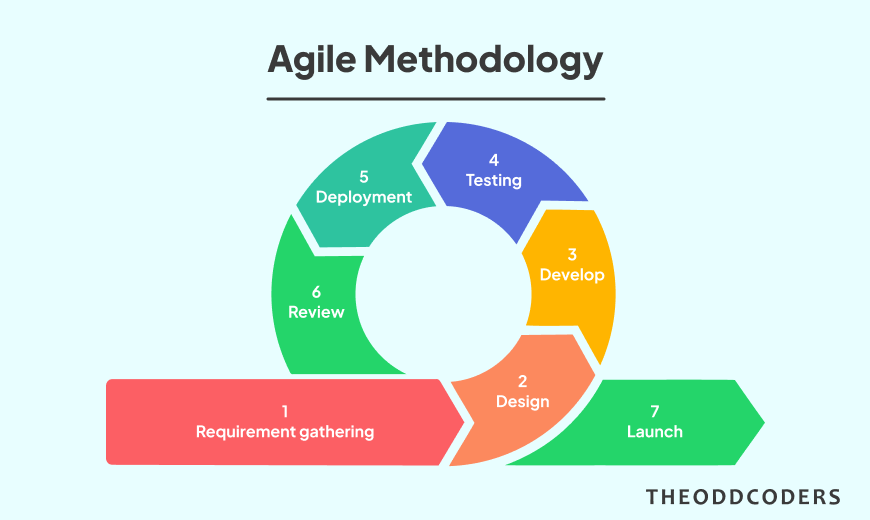
In this ever-evolving world of technology, selecting the proper software development model for your project is necessary for success. Adopting a software development model will set a tone for how your team will collaborate, plan, and execute the project. It will directly impact the efficiency, quality, and timeliness of your deliverables. In this blog post, we will see the different types of software development models that will be helpful in your project.
What is a software development model?
A software development model will give you the blueprint of your project by outlining the step-by-step process that will transform your idea into a real-time software solution. It provides structure and clarity to a development team throughout the whole lifecycle of the product. It is the one type of roadmap that will help you navigate through multiple stages, like collecting requirements, designing prototypes, coding, testing, and deployment. Hence, each model has unique techniques and practices that define each stage of software development.
Importance of selecting the software development model
Choosing the right software development methodology will help you create the best software for your business. It will define the framework and guidelines for the whole software development process. Let’s see some of the factors below.
#1 Quality Control
The proper methodology focuses on the quality of the code throughout the development lifecycle. It has implemented the processes for testing, reviews, and feedback loops by giving you top-quality software that will meet user expectations.
#2 Risk Mitigation and Quality Assurance
The project can be divided into smaller, more manageable pieces, allowing for proactive risk mitigation that will give you continuous quality monitoring and enhancement. The possibility of significant setbacks is decreased, and the overall quality of the finished product improves when the development team can adjust and change course as required.
#3 Acceptance of Project Objectives
Every project has a different goal, requirements, and demands. Selecting the proper methodology ensures that your development aligns with your project objectives, which helps you stay focused on achieving them.
#4 Adaptability and Flexibility
There are many changes in the project, whether in the requirements or the scope. A suitable software development model gives your project the required flexibility to accommodate these upgrades while also helping to minimize disruption and provide the project with success.
#5 Efficiency and Productivity
A well-defined software development model provides an efficient workflow and will also maximize productivity. It will also help streamline communication, task allocation, and resource management. It will also support a software development team to work more extensively and deliver the results on time.
Types of Software Development Models
To begin with your software development, you need to know and understand a distinct type of methodology that will best fit your unique project. The software development methodology you employ will represent a picture of your project workflow and drive the life cycle process with your advanced and latest technology. However, most standard and well-known popular software development methodologies are defined below.
Waterfall Model

The waterfall process model is the oldest software development methodology and follows a linear approach. This possesses a strategy, appropriate development methodology, well-defined requirements, and precise documentation at each stage. The waterfall product development methodology will break down the project into stages and complete each stage before moving on to the next. Let’s look at some of the stages of the software development process, which are as follows.
- Idea validation or Discovery
- Design and Prototype creation
- Development
- QA and Testing
- Deployment
- Constant Maintenance
It is a simple, easy, and systematic software development phase with clear and predefined goals. However, this method will work in the single sequential flow that moves on to the next, and due to this, it is named “waterfall.” Let’s look at some of the advantages of the waterfall development methodology, which are as follows.
Advantages of Waterfall Development
- The waterfall process model is a less complicated procedure with a simple and easy-to-manage SDLC.
- This procedure involves a well-planned structure with a linear sequence that will ensure a smooth workflow for the software development team.
- Clear documentation of the software development lifecycle will allow complete iteration tracking, creating a post-testing and feedback integration cycle.
- Simple and transparent budget estimation
- Well-defined project goals and objectives.
Disadvantages
- The major downside to the waterfall model is that if changes are required, they must be done in the previous stage before the project can move forward.
- The cost of iteration is high in its development methodology.
- A requirement formulation is required before beginning an SDLC process.
- Quality testing is done after the final product development, which will make it very complicated to spot all the bugs on time, leading to increased costs.
- Inflexible architecture.
- It is needed to work on complicated projects.
- It needs to monitor compliance with customer expectations.
Agile Methodology

The agile software development methodology possesses a dynamic methodology that involves working in sprints of two weeks or two months to build usable and efficient software that will respond to the real needs of users. The methodology or workflow model is critical for software projects requiring rapid iterations and frequent adjustments. It will break down the projects into smaller and more manageable units and then complete each chunk before moving on to the next phase.
Advantages of Agile Methodology
- The agile model will save time, allowing programmers to respond to project changes rapidly and create new adjustments as required.
- The agile software development approach enables the minor versions that relate to the test theories. It is more accessible to track bugs or roll back to the previous versions for the major problems, giving flexibility and control of the software.
- The agile development model approach will give you quick feedback and changes, leading to a faster development cycle.
Disadvantages
- One of the downsides to the agile development model is that it can be challenging to manage, and it is hard to keep track of and monitor the project’s progress.
- In this software development model, you need a lot of connections between developers, designers, consumers, and stakeholders.
Scrum Methodology

Scrum is a development methodology that focuses on collaboratively delivering your project’s value. This will possess an agile-adapted technique that will distinguish between flexibility and scalability. Scrum methodology will also excel in sprints and provide a structure for the people and teams that will work all together with a shared accountability that will optimize specific requirements and needs. This approach is ideal for projects that need frequent upgrades and adjustments.
The Scrum software development model usually works on inspection, transparency, and adaptation. It has the proper practices for iteration processes and ensures that the final result will be of optimum quality. Continuous tracking and feedback loops have a software development lifecycle that helps ensure that this product will match market trends and give maximum value.
Advantages of Scrum Methodology
- It makes quick iterations, boosting quality and adding value to a software product.
- A scrum approach will provide a flexible development model and follow a transparent process.
- This approach also enables regular team meetings, which will help with complicated software development needs.
- It continuously improves and upgrades the model based on collective responsibility.
- It gives better outcomes at a minimal cost via DevOps as a Service technique.
- The scrum software development model makes it easy to scale and produce with minimal risks.
- Large and complex development projects are executed in different phases with easy, manageable sprints.
- Software development projects will move quicker via a development lifecycle phase that will help to resolve the complexities.
- Accountability and shared ownership for project execution.
Disadvantages
- Since the Scrum process model has no set end date, scope creep tends to be the result.
- It is challenging for larger teams to operate and adapt.
- Involves minute management.
- Throughout the development cycle, every member of the team working on the project must be highly engaged.
DevOps Deployment Methodology

It is a game-changing approach that will improve all areas of project management. It takes less time to market projects and software releases, reduces failure rates, and helps developers be more efficient. It will give better results with minimal time and resources.
Advantages of DevOps Methodology
- It significantly reduces the time to market.
- Improve product quality and customer satisfaction.
- It will help to increase the productivity and efficiency of the employees.
- Automating repetitive tasks like testing and deployment will reduce manual errors and accelerate the development phase, making it more efficient.
- These model practices are conducive to scalability, allowing organizations to scale their infrastructure and apps as demand grows.
- A constant feedback loop will allow rapid response to changing requirements and quick identification and resolution of errors.
Disadvantages
- If overwork is well handled, DevOps’s fast-paced, continuous delivery-focused nature can be safe. Teams need to strike a balance between agility and sustainable practices.
- It may need an ongoing system update, which a client did not require.
- DevOps may not work for some industries because they need testing before moving on to the final product launch.
- While working with different departments, some undetected issues may be noticed.
How does the Software Development Model Work?
An organized structure or approach that leads to the development, execution, and maintenance of software systems is known as a software development model. These models outline the tasks, procedures, and phases of developing a software product. It also offers an organized method of software development. A brief description of a typical software development model’s functioning is provided below.

#1 Project Planning:
In any project, the first phase is planning the development process. This involves defining the project’s goals, time frame, scope, and required resources. Planning helps define stakeholders’ objectives and provides the development team with an agenda.
#2 Analysis of Requirements:
The software developers works with stakeholders during this stage to collect and evaluate the software requirements. Understanding functional requirements, user needs, and any limitations that can affect the development process are all part of this phase.
#3 Design:
A software blueprint is created throughout the design process using the requirements that have been acquired. This includes system design, architectural design, and comprehensive design specifications. Identifying the components and overall structure of the software is the goal of the designing phase of the project.
#4 Coding (implementation):
This stage involves coding the software. Developers follow the design specifications while writing code. The design is transformed into a working software system during the implementation phase. Version control, coding standards, and coding practices are crucial factors considered at this phase.
#5 Testing:
An essential step in the software development process is testing. It involves systematically analyzing the software for mistakes, ensuring it fits the requirements, and validating its functionality. User acceptance testing, system testing, integration testing, and unit testing are a few examples of testing techniques.
#6 Deployment:
The software is made available for use when it has passed testing and validation. Installing the software on end-user devices, servers, or cloud platforms can be called deployment. Configuration and release management procedures are frequently employed to ensure a seamless deployment process.
#7 Maintenance & Updates:
The software goes into maintenance after it is installed. This involves responding to and resolving problems in a real-life environment and updating or enhancing the system in response to user input or changing specifications.
#8 Feedback Continually (for Agile Models):
Iterations occur in agile development frameworks like Scrum and Kanban. Stakeholder feedback is collected at the end of each sprint or iteration, and changes are made before moving to the next iteration. For every day of the development lifetime, this iterative feedback loop is maintained.
#9 Documentation:
Documentation is created during development to capture decisions about design, coding standards, testing procedures, and other relevant information. Knowledge transfer, maintenance in the future, and ensuring that the architecture and functionality of the software are recognized have all been made possible by documentation.
These phases may be organized differently in software development frameworks like Waterfall, Agile, or Scrum. The type of software being built, organizational preferences and project needs to play a significant role in the model selection process. Sticking to a systematic and organized approach is the key to successfully developing and sustaining high-quality software.
Conclusion
Which software development model is perfect for your business? This article has given you some ideas to help you make well-informed decisions. Also, the best model fits your company’s culture, process, and objectives. Hence, you can try various methodologies until you find the best one.
Moreover, watching the new developments and techniques you can adapt to software development would be best. If you have any queries, then you can connect with the best software developers from the leading ERP software development company in India.
Read More:- ERP: Discover the What’s, Why’s and How’s in This Ultimate Guide



